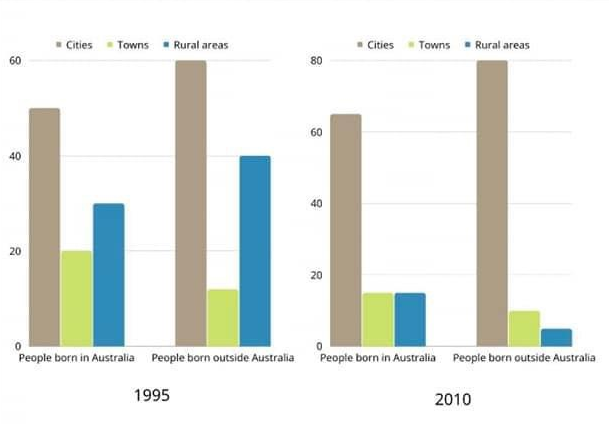[Fahmi Rizki F] Writing Practice Test 1396376
Task 1
You should spend about 20 minutes on this task.
The bar chart below describes some changes about the percentage of people were born in Australia and who were born outside Australia living in urban, rural and town between 1995 and 2010.
Summarise the information by selecting and reporting the main features and make comparisons where relevant.
You should write at least 150 words.

In both years, people born in Australia predominantly resided in cities, with significantly lower percentages living in towns and rural areas. This trend is consistent for those born outside Australia, although the percentage differences between living areas are more pronounced for this group.
There was a noticeable increase in the percentage of people born in Australia living in cities from 1995 to 2010, with a corresponding decrease in the percentages living in towns and rural areas. This suggests an urbanization trend among the native-born population.
For individuals born outside Australia, there was also an increase in the percentage living in cities, although the increase was not as dramatic as that for the native-born population. This indicates that while the foreign-born population was also moving towards urban areas, the change was more gradual.
The percentage of people born outside Australia living in towns and rural areas was significantly lower compared to those born in Australia in both 1995 and 2010. However, the decline in these percentages from 1995 to 2010 was more marked for the foreign-born population, reinforcing the urbanization trend.
Comparing the two groups, people born outside Australia were less likely to live in towns and rural areas in both years, which may suggest a preference or tendency for the immigrant population to reside in urban centers.
The most significant change over the 15-year period was observed in the city-dwelling population, particularly among those born in Australia, which could be attributed to a variety of factors such as employment opportunities, educational facilities, and lifestyle preferences.
In summary, the data indicates a clear trend towards urbanization among both the native and foreign-born populations of Australia from 1995 to 2010, with the most substantial changes occurring in city living percentages. The data also shows that in both 1995 and 2010, individuals born outside of Australia were more concentrated in cities compared to towns and rural areas when compared to the native-born population.
Task 2
You should spend about 40 minutes on this task.
Rich countries often give money to poorer countries, but it does not solve poverty. Therefore, developed countries should give other types of help to the poor countries rather than financial aid. To what extent do you agree or disagree?
You should write at least 250 words.
The debate over the effectiveness of financial aid has been ongoing for decades. Critics argue that while such aid can provide immediate relief, it often fails to lead to sustainable development or to resolve the underlying causes of poverty. On the other side, proponents believe that financial aid, when used appropriately, can be a catalyst for change and improvement.
I partly agree with the notion that developed countries should provide types of assistance other than financial aid to help poorer countries. However, the assertion that financial aid does not solve poverty is an oversimplification of a complex issue. Monetary assistance, if managed and distributed effectively, can indeed alleviate poverty by providing the necessary resources for development projects, improving infrastructure, and enhancing education and health care systems. The problem often lies not with the financial aid itself, but with how it is implemented—issues such as corruption, poor governance, and lack of accountability can lead to aid being ineffective.
That said, there are alternative forms of help that can be more sustainable in the long term. One such form is capacity building, which involves providing education and training to help individuals in developing countries acquire the skills needed to improve their livelihoods. Additionally, sharing technology and providing access to information can empower poorer countries to innovate and progress independently.
Another key form of assistance is trade facilitation. By opening markets and reducing trade barriers, developed countries can enable poorer nations to benefit from increased access to global markets. This can be more beneficial than financial aid as it promotes self-sufficiency and economic growth through the private sector.
Partnership programs that focus on governance and institutional development can also have a more lasting impact. By supporting the establishment of effective, transparent, and accountable institutions, developed countries can help create an environment in which economic growth is more likely to reduce poverty sustainably.
In conclusion, while financial aid should not be entirely dismissed as a tool for poverty reduction, it should be complemented with other forms of assistance that target sustainable development. The focus should be on creating a balanced approach that includes capacity building, technological cooperation, trade facilitation, and institutional support, tailored to the specific needs and contexts of the recipient countries. This multi-faceted approach increases the likelihood of not just alleviating poverty temporarily but eradicating it in the long term.
Community’s feedback
Sorry! We couldn't find any contents.
Score Given by Community
Give a bandscoreLeaderboard:
| # | User | Score | Time | |
|---|---|---|---|---|
| Kento Nanami |  | 8.5 | 52:31 | |
| Nayef Alhajraf |  | 8.5 | 60:00 | |
| Ella Ruppo |  | 7.5 | 59:39 | |
| 4 | chengxi yu |  | 7.0 | 00:00 |
| 5 | avin chui |  | 7.0 | 59:11 |
| 6 | 癫 火 |  | 7.0 | 59:51 |
| 7 | Li Xuefeng |  | 6.5 | 03:46 |
| 8 | Chanisara Wongkongsang |  | 6.5 | 56:37 |
| 9 | Dan H |  | 6.0 | 50:41 |
| 10 | Carlo Di Giacomo |  | 6.0 | 60:00 |



